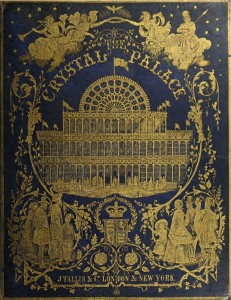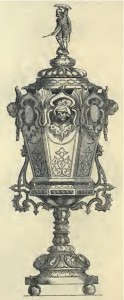It’s been a while since I’ve posted anything substantial on the Crystal Palace, so I’ve decided to focus a few posts on gathering together resources that are available on line – mainly 19th century stuff from Google books and archive.org for the time being. With this in mind, it makes sense to begin at the beginning, with catalogues from the Great Exhibition in 1851.
The Official Descriptive and Illustrated Catalogue of the Great Exhibition of the Works of Industry of All Nations, 1851, Volume 1 (also on Google books).
This lists the exhibits from the UK, British colonies, and foreign countries. The title notwithstanding, there do not appear to be any illustrations in this volume. From my point of view, the Russian exhibit (pp. 290-95) is particularly interesting. It mainly consists of raw and processed materials, with iron and other ores, malachite, and leather all prominent. This, I assume, is the reason why illustrated catalogues (see below) do not dwell for very long on the Russian exhibit. One thing caught my eye, however, from p. 294: ‘Item 282. A Cossack’s Wife, Orenburg, Prod.–Shawl of white goat’s hair’. Orenburg shawls are still going strong, and I still wear the one I bought twenty years ago in Moscow. It’s good to know that amidst all the machinery, sculpture, vases and candelabra, there was also room for such beautiful but essentially quite humble items.
The Official Descriptive and Illustrated Catalogue Volume 2 (also on Google books).
A more descriptive approach, featuring mainly manufactured goods from the UK and the colonies.
The Official Descriptive and Illustrated Catalogue Volume 3.
Featuring the exhibits from foreign countries, again in more descriptive form, and with illustrations, although the scanning leaves something to be desired. The Russian entry can be found pp. 1361-87.
Then it starts to get confusing; the first three volumes claim that the Official Catalogue is in three volumes, but there appears to be a fourth volume. This features colonies and foreign states and appears to have much of the same stuff as volumes 2 and 3, but it ends before it gets to Russia. There’s also a second edition, from July 1851, with more information about visiting the exhibition etc.
Companion to the Official Catalogue. Synopsis of the Contents of the Great Exhibition of 1851, by Robert Hunt, does exactly what it says on the tin. The description of the Russian contribution is on pp. 75-6, and confirms the importance of malachite to the Russian exhibit.
A couple of national catalogues are also available:
Exposition universelle de 1851: Travaux de la Commission française sur l’industrie des nations, tome III (1854)
Then there is Tallis’s history and description of the Crystal Palace, and the Exhibition of the world’s industry in 1851 (published 1852):
Division 1
Division 2
Division 3
Division 4
Division 5
The engravings are superb quality, and generally seem very well scanned, but for some reason they’re presented at the beginning of each volume, while if you open the book on line, it jumps straight to the text.
Two other essential (and beautiful) contemporary resources are:
A fascinating book with some fabulous engravings – this one is of a silver cup by Paul Sazikoff of Moscow (p. 266). I was lucky enough to pick up a facsimile copy from Kirkdale bookshop in Sydenham last year and love browsing though it.
The Crystal Palace and its Contents: being an illustrated cyclopaedia of the great exhibition of the industry of all nations, 1851: embellished with upwards of five hundred engravings, with a copious analytical index
Particularly interesting here is the feature on Prince Albert’s Model Houses for Families (p. 81) – these, of course, survive, and can now be found in Kennington Park.


